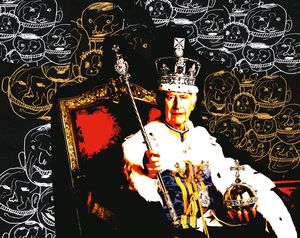The coronation pageantry unveiled the dilemma facing King Charles III. How to combine myth-making with modernising the British monarchy in an era of declining public support? Medieval myths mesmerise masses. But modernisation is essential for the monarchy’s relevance and continuity. Few can glamourise tradition better than the British. But, says historian Vernon Bogdanor, “The monarchy is no longer a mystical, magical institution. It is a public service institution. It will be evaluated now in public service terms.”
Some coronation rituals do no service to the monarchy. They are tone deaf, even absurd. The 152kg “coronation stone” called the “stone of destiny” exemplified skewed optics. Hidden under King Charles’ coronation throne, it originally symbolised continuity of the monarchy—Scottish, not English. He was literally sitting on a symbol of Scottish sovereignty at a time when the Scots are trying to break free from Britain. The Scottish stone was seized in 1296 by English King Edward 1, called “Hammer of the Scots” because he kept invading Scotland. The stone failed to bring stability and Edward lost control of Scotland. Legend claims the Biblical Jacob rested his head on this stone. According to the Bible, Jacob lived 3,500 years ago in Palestine. How did this stone get to Scotland? It did not. Geological analyses prove it came from where it belonged—Scotland.
Then came the secret anointing ritual from the Old Testament, symbolising God’s consecration of King Charles. We must take their word for it because Charles was hidden behind screens for this rite. Today, divine right to rule is considered absurd, even in Japan where emperors mythically descended 6,000 years ago from the sun goddess. In the run-up to this coronation, television anchors parroted palace propaganda; “King Charles is a man of faith, he is a man of God.” Forgotten were the accusations of adultery and cruelty levelled against him by his first wife and second son, now an outcast.
Particularly tone deaf was the feudal tradition of paying homage to the new king. King Charles’ “magnanimous” gesture to extend this privilege from peers to commoners was supposedly an inclusive social coup. “But we want the monarchy to swear allegiance to us, not the other way round,” protested advertising guru Richard Huntington. “Not My King” posters popped up. Responding to widespread criticism, King Charles’s opening coronation statement was, like the Lord, “I come not to be served, but to serve”. That sentiment was underscored a dozen times during the ceremony. But even in expressions of humility, the new King was in the company of the divinely-ordained Jacob, Jesus and English kings of yore.
But public indulgence of mad and merry kings is over. Modernity is an imperative, not a choice. Experts agree King Charles has begun well, embracing the multi-faith, multicultural mosaic of modern Britain. He has championed social and environmental causes, even promising to donate windfall profits to public good. The profits come from offshore windfarms located on Britain’s seabeds owned by the crown. In other constitutional monarchies, seabeds are publicly-owned and royal rituals slashed drastically.
Still, King Charles is cutting expenses to trim and modernise the monarchy. Royal biographer and consultant of Netflix series Crown, Robert Lacey says, “King Charles is much more popular than Prince Charles.” Coronation captures the contradictions of the monarchy, its glory and its absurdity. “The wonderfully choreographed coronation makes Britons feel special,” says British historian Linda Colley, but “it also shows that both nation and monarchy need to modernise. Britain badly needs to moderate its self-deceiving sense of exceptionalism”.
Pratap is an author and journalist.


